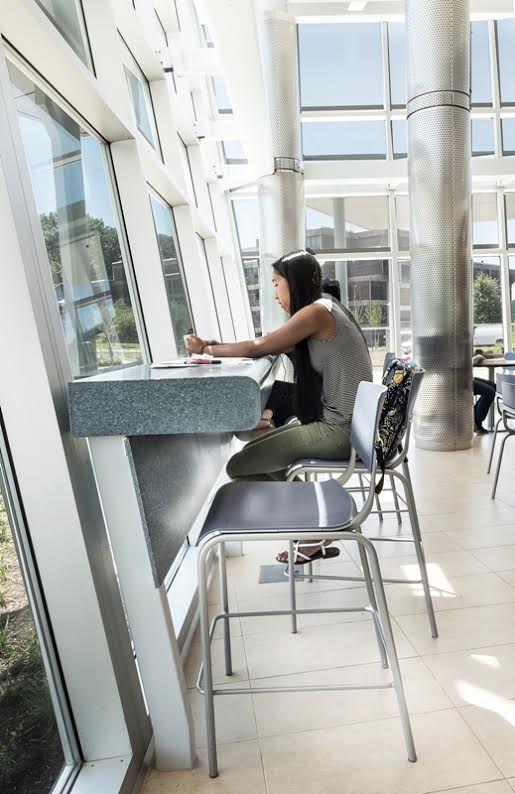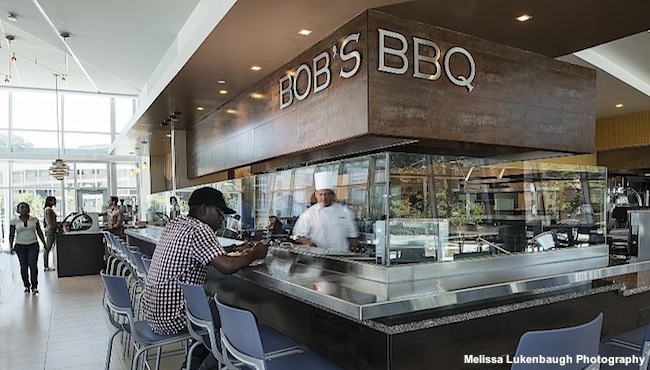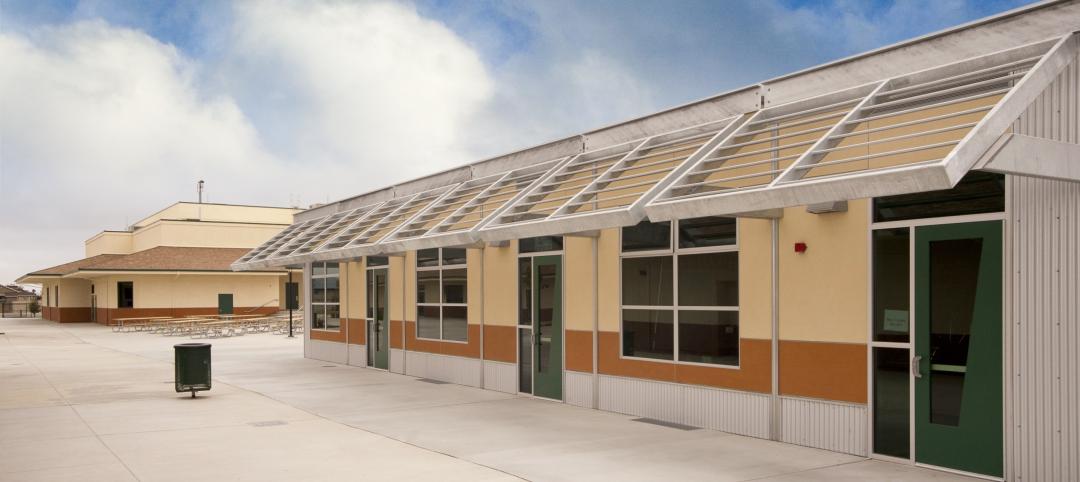Creating a dining experience for the modern millennial requires not only a deep knowledge of good design, but also an understanding of what makes today’s students tick.
KSQ Architects dining specialist Juana Gomez, as well as culinary designers and consultants from Bakergroup and Ricca Newmark, recently provided insights into what trends are transforming the campus table.
1. Food is community
Sure, some students simply want to eat in peace–and creating bar height spaces where they can feel comfortable dining alone is key. But because family is increasingly important to the millennial generation, many students prefer the communal act of dining with others. This shared experience gives birth to community and raises the level of engagement on campus.
In fact, a survey of 1,000 millennials by marketing agency BBDO Atlanta found that “48% said their families define them, and 16% said their passions do. Honesty ranked highest in what matters most in how they live their lives. Pretentions are out. Honesty and transparency are in. And, integral to their lifestyle is the food they eat and the people they eat it with.” Flexible spaces that support any given mood–whether solitary or communal–are key to any successful student dining project.
2. Restaurant, not cafeteria
Dining halls today are not the cafeterias of yesterday. Today’s students want a more retail experience and they want variety–and ideally multiple choices of fresh foods prepared right in front of them and to their specifications. In fact, the BBDO survey also found that nearly five out of 10 millennials refer to themselves as foodies. Sophisticated yet durable finishes, comfortable lighting and seating, and inviting spaces to simply hang out whether they’re hungry or not.
“Dining on campus is evolving more into commercial restaurants and farther away from the “stainless” cafeterias of my collegiate days. Instead of “dining halls” we are going to “mini-restaurants” and “marketplaces,” says Tom Ricca, founder of culinary design firm Ricca Newmark. “Student dining rooms today are furnished with upholstered booths and banquettes with highly designed ceilings and lighting.”
3. Connection to the outdoors

Photo credit: Melissa Lukenbaugh Photography, courtesy of KSQ Architects
Whether it’s an indoor space flooded with natural light or a true al fresco dining experience, students crave sunlight as much as a slice ofpizza. Nothing raises the mood, inspires conversation and communicates hospitality like a wall of windows or a patio full of tables.
“Especially in climates that are more temperate, we like to provide spaces that allow students to take the dining experience outside,” says KSQ associate and dining specialist Juana Gomez. "Having options is vitally important to students today, and al fresco dining–with a variety of seating choices–really lets millennials create what feels like a customized eating experience.”
4. Food origins
Not only do 21st century college students think differently about food than any previous generation, they also care deeply about the origins of their food–whether the emphasis is on how it’s grown, where it’s grown or who grew it, the ethical factors that come into play are increasingly important to this new generation.
“Students are also seeking more transparency and authenticity in the preparation of their food, reflected in the popularity of exposition cooking and artisan foods, and in the demand for fresh ingredients,” says Jim Sukenik, president of food service consultant Bakergroup. “A movement toward local food sourcing is a driver of chef-driven menus that frequently change, based upon the seasonal availability of some items.”
5. Spaces with flex appeal
Let’s face it–today’s millennial is easily bored. Finding ways to keep a dining hall ever new is a challenge that can be achieved with revolving art exhibits, new music, updated menus and branding opportunities. Keeping the experience fresh is a key factor in making dining a place that pulls kids from all corners of campus.
“Like a storefront window, the dining hall ideally has something new going on all the time,” says KSQ’s Gomez. “Often a small stage–for students to play music, have poetry readings or do improv–can be a big attraction.”
6. Convenience, always
A recent article by physicians with the Mayo Clinic noted that trends indicate 35% of meals eaten by millennials are actually snacks. Which means the portion sizes and dining hours need to be flexible. Whether it’s hours of operation or locations on campus, students tell us they want convenience and choice. Dining in with friends, grab-and-go on the way to class or delivery are also options students look for to make their hectic life a little easier.
“Convenience is paramount – foods that students want, where and when they want them,” says Sukenik. “Fresh, local, and healthy ingredients; smaller portion sizes; snacking and grazing in lieu of full meals, and “trading plates” are growing trends.” Tom Ricca agrees. “With the mobility of our youth, constantly connected, and time-challenged, we see the need for more and more “portable” foods that can be easily hand-held, packaged and eaten on the move. This would be items like burritos, pasties, and empanadas,” he says.
7. Going global

Photo credit: Melissa Lukenbaugh Photography, courtesy of KSQ Architects
From their own travel experiences to what they’ve seen on YouTube and Food Network, today’s students are far more savvy about ethnic foods, emerging food trends and unique dietary requirements to meet their needs. Students have also gravitated toward specialty beverages including craft teas, local soft drinks and infused water.
“The food itself responds to the ever-increasing sophistication of today’s teenager, who has eaten more meals in restaurants in his/herlifetime than at home, has travelled internationally and has experienced multi-cultural cuisines and cooking techniques from around the globe,” says Ricca. “Gone is the era of pizza, burgers and delis–now we have churrascos, Mongolian BBQ, dim sum and gyros.”
“Gluten-free menu items continue to gain traction, as many give up wheat products for health and lifestyle reasons,” adds Sukenik. “Ancient grains and nuts have become popular alternatives to wheat and meat, though smoked meats and other foods continue to rise in popularity,” he says.
8. Dine in, plug in

Photo credit: Melissa Lukenbaugh Photography, courtesy of KSQ Architects
Technology doesn’t stop with the lunch hour. In fact, for many students, the dining experience always includes either a smart phone, laptop or flatscreen TV. More than one-third of respondents to the BBDO survey said they like tech perks in dining venues, including ordering on iPads and pre-orderings with smart phones. Ironically, while 88% said they look at their phones while eating, 44% said they dislike it when their friends do.
Today’s dining halls feature seamless integration of technology, with power outlets built into furnishings, WiFi access (67% in the BBDO survey said they want free WiFi in restaurants) and digital connections to nutritional information, menus, surveys and even suggestion “boxes.” Walls with large-format televisions allow for communal TV or movie viewing and even the occasional video game tournament.
“Students today want to stay connected, even when they’re dining,” says KSQ’s Gomez. “Even if a dining hall doesn’t feature televisions, kids are looking at their phones. It’s a reality our designs must support—this is a generation that views their smartphone as a physical extension."
Related Stories
| Feb 23, 2011
“School of Tomorrow” student design competition winners selected
The American Institute of Architecture Students (AIAS) and Kawneer Company, Inc. announced the winners of the “Schools of Tomorrow” student design competition. The Kawneer-sponsored competition, now in its fifth year, challenged students to learn about building materials, specifically architectural aluminum building products and systems in the design of a modern and creative school for students ranging from kindergarten to sixth grade. Ball State University’s Susan Butts was awarded first place and $2,500 for “Propel Elementary School.”
| Feb 15, 2011
LAUSD commissions innovative prefab prototypes for future building
The LA Unified School District, under the leadership of a new facilities director, reversed course regarding prototypes for its new schools and engaged architects to create compelling kit-of-parts schemes that are largely prefabricated.
| Feb 11, 2011
Four-story library at Salem State will hold half a million—get this—books!
Salem State University in Massachusetts broke ground on a new library and learning center in December. The new four-story library will include instructional labs, group study rooms, and a testing center. The modern, 124,000-sf design by Boston-based Shepley Bulfinch includes space for 500,000 books and study space for up to a thousand students. Sustainable features include geothermal heating and cooling, rainwater harvesting, and low-flow plumbing fixtures.
| Feb 9, 2011
Gen7 eco-friendly modular classrooms are first to be CHPS verified
The first-ever Gen7 green classrooms, installed at Bolsa Knolls Middle School in Salinas, California, have become the nation's first modular classrooms to receive Collaborative for High Performance Schools (CHPS) Verified recognition for New School Construction. They are only the second school in California to successfully complete the CHPS Verified review process.
| Jan 21, 2011
Primate research facility at Duke improves life for lemurs
Dozens of lemurs have new homes in two new facilities at the Duke Lemur Center in Raleigh, N.C. The Releasable Building connects to a 69-acre fenced forest for free-ranging lemurs, while the Semi-Releasable Building is for lemurs with limited-range privileges.
| Jan 21, 2011
Virginia community college completes LEED Silver science building
The new 60,000-sf science building at John Tyler Community College in Midlothian, Va., just earned LEED Silver, the first facility in the Commonwealth’s community college system to earn this recognition. The facility, designed by Burt Hill with Gilbane Building Co. as construction manager, houses an entire floor of laboratory classrooms, plus a new library, student lounge, and bookstore.
| Jan 20, 2011
Community college to prepare next-gen Homeland Security personnel
The College of DuPage, Glen Ellyn, Ill., began work on the Homeland Security Education Center, which will prepare future emergency personnel to tackle terrorist attacks and disasters. The $25 million, 61,100-sf building’s centerpiece will be an immersive interior street lab for urban response simulations.
| Jan 19, 2011
Biomedical research center in Texas to foster scientific collaboration
The new Health and Biomedical Sciences Center at the University of Houston will facilitate interaction between scientists in a 167,000-sf, six-story research facility. The center will bring together researchers from many of the school’s departments to collaborate on interdisciplinary projects. The facility also will feature an ambulatory surgery center for the College of Optometry, the first of its kind for an optometry school. Boston-based firms Shepley Bulfinch and Bailey Architects designed the project.
| Dec 28, 2010
Project of the Week: Community college for next-gen Homeland Security personnel
The College of DuPage, Glen Ellyn, Ill., began work on the Homeland Security Education Center, which will prepare future emergency personnel to tackle terrorist attacks and disasters. The $25 million, 61,100-sf building’s centerpiece will be an immersive interior street lab for urban response simulations.
| Dec 17, 2010
Sam Houston State arts programs expand into new performance center
Theater, music, and dance programs at Sam Houston State University have a new venue in the 101,945-sf, $38.5 million James and Nancy Gaertner Performing Arts Center. WHR Architects, Houston, designed the new center to connect two existing buildings at the Huntsville, Texas, campus.

















